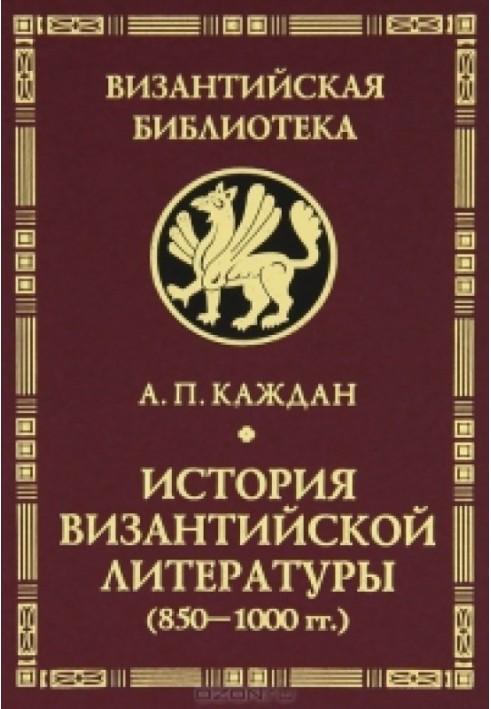History of Byzantine literature (850-1000). The era of Byzantine encyclopedism
 Instant download
Instant download
after payment (24/7)
 Wide range of formats
Wide range of formats
(for all gadgets)
 Full book
Full book
(including for Apple and Android)
According to the plan of the author of the "History of Byzantine Literature", this fundamental work was supposed to cover a period of six centuries - from the 7th to the 12th centuries, but, unfortunately, Alexander Petrovich did not have time to complete it - only three parts were written, in which the history of literature extends only to the end of the 10th century. The third and last part examines the literature of the next century and a half (c. 850 - c. 1000) - a period usually called the Macedonian Renaissance or the era of Byzantine encyclopedism. The book by A.P. Kazhdan, completely unusual and innovative in its method, allows you to evaluate the literature and culture of this interesting time in a completely new way - it creates a complete picture of Byzantine literature, traces the main trends in its development, reveals characteristic features of the era or even the individual style, the “handwriting” of Byzantine authors, many of whom were previously seen as faceless epigones of the ancient tradition. The book is of interest both to specialists and to a wide range of readers interested in the culture and literature of the Middle Ages. Contents: Introduction (translated . D. R. Abdrakhmanova) ............................................... ...............5Chapter one. Photius (translated by D. R. Abdrakhmanova).....................................11A. Biography................................................. ................................................11B . “Myriobiblion” or “Library”: style theory....................................................15C. Literary activity: letters and sermons....................................................32D. Students Photia................................................... ........................................44Chapter two. George the Monk: a trivial Chronicle (translated by D. A. Chernoglazov).................................................... .......................49Chapter three. Eloquence around 900: “School” by Photius (translated by V. G. Gertsik)................................... ........................................................ ..........60A. Leo VI the Wise, or Philosopher............................................ ...................60B. Nikolai Mystic................................................ ........................................74C. Arefa of Caesarea: the art of self-defense.................................................. 84D. Some other writers around 900................................................. .......Chapter 95 fourth. Nikita-David Paphlagonian: revival of the pamphlet (translated by M. L. Kisiliera)................................... ......................102A. Biography. Nostalgia for the heroic past....................................102B. Life of Ignatius or pamphlet on Photius.................................................... .......109Chapter five. The meek patriarch and the emperor in tears: the life of Patriarch Euthymius (translated by M. L. Kisilier)......................... .........115Chapter six. Provincial writers of the late 9th-early 10th centuries. (translated by V.V. Fedchenko)............................................ ...................125A. Peter of Argos: Constantinople in the Peloponnese....................................125B. Some provincial hagiographic works...................................130C. The story of the capture of Thessalonica in 904 g........................................ ....138Chapter seven. At the court of Constantine VII Porphyrogenitus (translated by D. A. Chernoglazov).................................... ........................................145A. Biography of Vasily 1................................................... ........................149B. The successor of Theophanes and the “Book of Kings”.................................................. .....157C. Eloquence in poetry and prose.................................................... ....................166D. Anti-Macedoan chronicle................................................................. ...................177E. Other contemporaries of Constantine VII.................................................... .....186Chapter Eight. Three Lives of Constantinople from the mid-10th century (translated by M. L. Kisiliera)......................................................... ...............................202A. Life of Basil the New, written by His spiritual son Gregory (BHG 263-2640................................................... ...202B - “The Life of Andrei the Fool for Christ”, Written by the priest Nicephorus (BHG 115z-l 17k).........................211C . Anonymous life of Niphon (BHG 1371z)................................... ....220D. Some similar (and different) Constantinople hagiographic works.................................224Chapter nine. Paul of Latria and other saints from the provinces (translated by M. L. Kisiliera)................................... ..................231A. Righteous “escape from life”: “the life of Paul the New from Latros”......231B. Similarities and differences: the life of Demetrius Khitrsky........................239C. The Wandering Saint: The Life of Blaise of Amoria....................................................243D. Small hagiographical forms: Paul of Monemvasia....................................248Chapter ten. The Great Reader and Collector: Simeon Metaphrastus (translated by M. L. Kisiliera)................................... ............253A. Predecessors and contemporaries................................................................... ..........253B. Biography................................................. ...........................................255C. Menology........................................................ ...............................................258Chapter Eleven. John the Geometer and “political” poetry (translated by V.V. Fedchenko)........................................ ....................................272A. Instead of a biography................................................... ...................................272B. Political poetry................................................... ...............................275C. Fading homiletics................................................... ...........................286D. Playful rhetoric: progymnasms.................................................... ..........291Chapter Twelve. Knightly historiography: Leo the Deacon and his contemporaries (translated by D. A. Chernoglazov)................................................. ....298A. Valiant warriors in the historiography of the late 10th century....................................298B. Leo Deacon. Biography................................................. ...........................304C. History in ten books................................................... ...........................306D. The legend of the murder of Nikephoros Phokas.................................................... .......313E. Some epistolographers of the era of Vasily II....................................................316Chapter thirteen. “Patriot” or the revival of Lucian from Samosata (translated by S. E. Andreeva)................................. ......................322A. Lucian in Byzantium................................................... ...................................322B. On the dating of “Philopatrix”................................................. .......................324C. Anti-Christian, anti-monastic or neutral dialogue?..........325Chapter fourteenth. Gabriel: between hymography and hagiography (translated by D. R, Abdrakhmanova)................................... .......331Chapter fifteen. Literature of the era of encyclopedicism (translated by D. A. Chernoglazov).................................................... ...................................339A. Education and book writing......................................................... ...................339B. Authors................................................. ........................................................ ...345C. Antiquity and the decline of traditional genres.................................................348D. Hero, composition and scenery.................................................... .................355E. Sargent literatus................................................... ...............................360F. Language, or "style"............................................... ...........................................363List of abbreviations.......... ........................................................ ...............367
Data sheet
- Name of the Author
- Александр Каждан Петрович
- Language
- Russian

















